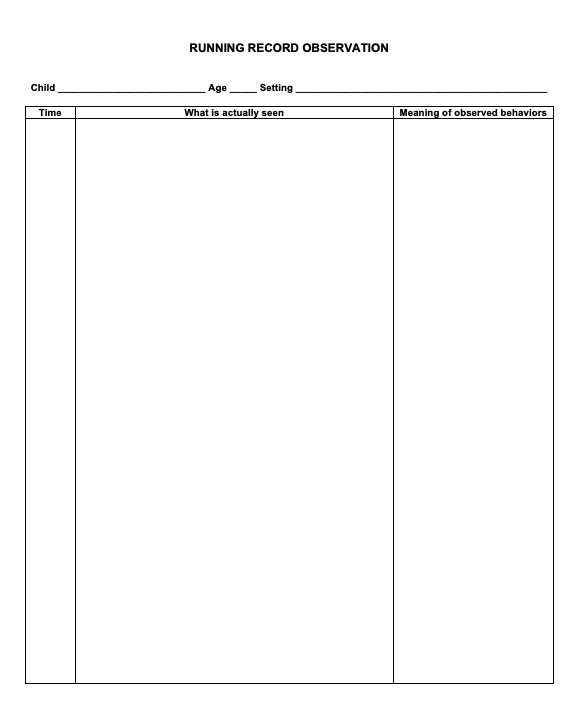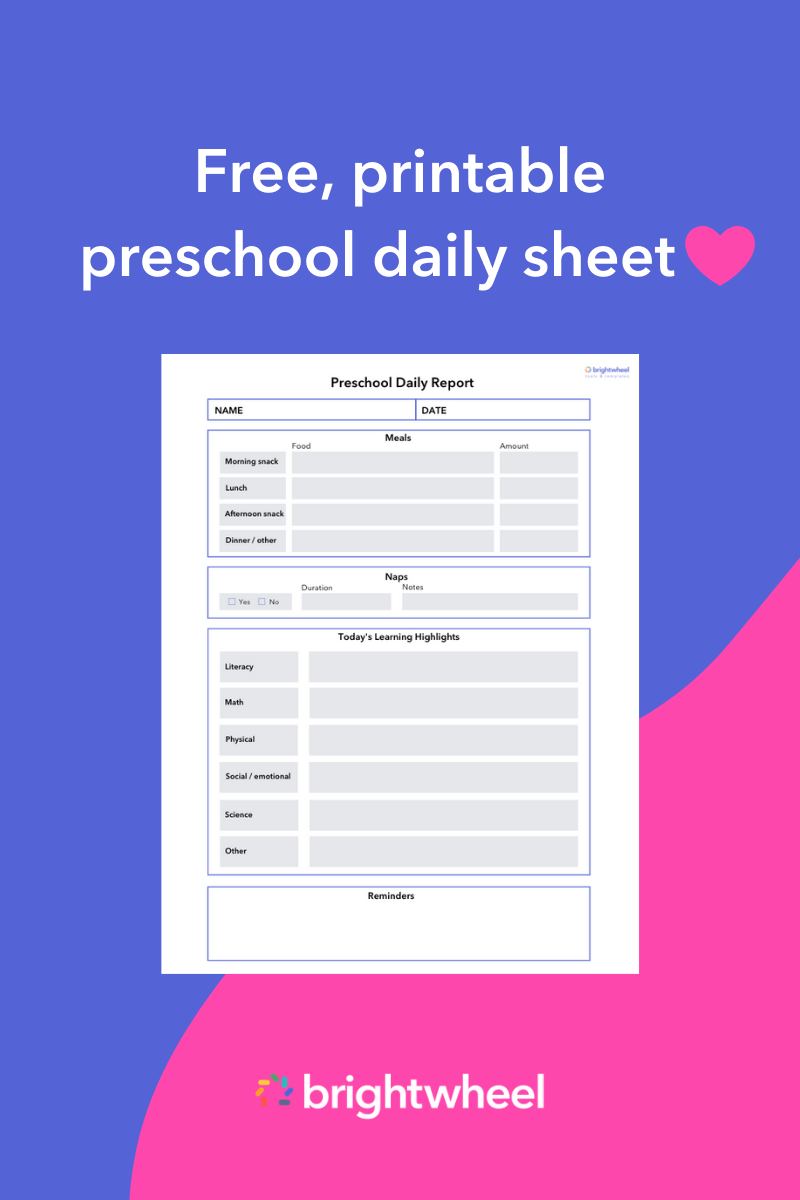As an educator, you’re tasked with many responsibilities. The core of early childhood education is to help young children build a foundation of knowledge and skills that they’ll continue to build upon as they progress toward becoming successful, well-adjusted adults.
Your duties go beyond teaching basic academic skills. You’re also responsible for guiding lesson plans and managing classroom behavior. Your role encompasses encouraging and supporting your children’s strengths and communicating their progress to their families to create strong partnerships.
Another important aspect of being an educator is being an observer. To effectively manage your classroom, support your children, and communicate with families, you’ll need to regularly observe and monitor your children’s progress. You’ll need to watch your young learners as well as the situations or events that take place in your presence. And while it’s impossible to watch everyone at all times, setting time aside to watch an individual child and conduct a running record observation can help you gauge their performance and behavior for a better understanding of their progress.
In this article, we’ll discuss running records—what they are, their importance in early childhood education, and how to write them.
What is a running record?
A running record is a type of childhood observation method used to capture detailed documentation of a child’s activity or behavior while it is happening. These are typically written in the present tense and only contain objective information, not influenced by personal feelings or opinions. Running records should include everything that happens during the designated period of observation as it happens.
This observation tool is often used to gain insight into a young child’s development. A running record provides a descriptive and comprehensive sequential account of a specific activity, giving an unbiased record of the facts including what a child is saying or doing. Running records are often used to assess a child’s reading skills, allowing teachers to accurately and objectively record what young readers say and do during oral reading. However, there are many applications for running records in an early education setting. Regardless of the behavior you are observing, running records help educators learn more about a child and their unique needs and use that information to inform future lesson plans.
Preschool Daily Sheet
Use this template to document child's activities, meals, naps, and learning throughout the day.
In any setting, running records give educators the ability to analyze what happened and plan appropriate instruction. They allow you to:
- Guide teaching
- Observe children and their strategies as they problem solve
- Document children’s learning over time
- Assign suitable work for current abilities
- Share progress with families
Keeping up with the progress of your children is an important step to ensuring that they’re actively learning. To follow and document their progress, running record observations should be conducted regularly. For children who are struggling at their current level, these observations should happen more frequently than for those who are on level or above level. This will allow you to make timely changes in their learning to help guide their progress. While you might set aside time to observe a struggling child every one to two weeks, you might take a running record for an emerging or proficient child every three to four weeks.
Running record and anecdotal record
An anecdotal record is another method of child observation that is a brief written record of a snapshot in time, documenting what a child says or does during classroom activities or routines. Anecdotal records are typically quick and easy to write and shorter in length than running records. This note is usually written in the past tense and includes specific details of an event as well as important context such as when the event happened, where it took place, who was involved, and what happened. It is another method teachers may use to collect information about a child—their behavior, skills, attitude, performance, and activities.
Like running records, anecdotal records should be objective. Assumptions and opinions should not be included in the observations. For example, imagine you are writing an anecdotal record of a girl named Laura after her playtime with classmates. An anecdotal record that includes your assumptions might be: “Laura happily shared her toy with David after he asked to play with it.” In this example, you are assuming that Laura was happy about sharing with her classmate. Instead, you might write: “After David asked Laura if he could play with her toy, she smiled and handed him the toy.”
Running records and anecdotal records also share many of the same benefits. They allow you to:
- Record qualitative information about children
- Identify children’s needs, behavior, and learning patterns
- Track progress and changes in behavior and performance
- Identify areas of weakness
Both observation methods are effective tools for measuring children’s progress and identifying their strengths and needs.
When comparing the two methods, running records are typically more detailed. While anecdotal records are usually brief notes of a child’s actions, running records are meant to include as many detailed notes as possible from the period of observation. Due to this detailed nature, running records can take teachers more time to write.
Since there are pros and cons to any observation method, you’ll find it beneficial to adopt multiple tools for assessment. Child development is complex, and a series of tools, including running records and anecdotal records, can help you better understand children’s progress and growth.
How to write a running record
All children are different. They don’t learn or develop in the same ways. Using an observation tool like running records can help you customize your instruction to cater to the different needs of your learners. The process of conducting a running record observation for each child can get overwhelming, but these tips should help.
Create a schedule
Setting aside time to conduct a running record observation for each child can be intimidating. Create a schedule to make this process easier. Decide how often you will conduct running record observations and develop a schedule where one or more children are assigned to each teacher on a specific day of the week.
Observe one child at a time
To conduct an accurate running record, make sure the observations focus only on one child at a time. In creating your schedule, you may decide to assign a few observations for different children throughout the day. This system is still efficient; however, you need to ensure that teachers are observing the behavior, skills, and events of only one child at a time.
For example, imagine two children, Claire and Emmy, playing together. While you are observing Claire, it might be easy for the behavior of Emmy to trickle into your observation. You might write: “Emmy yells, causing Claire to become alarmed.” Not only have you directed this observation toward Emmy, but you have also made an assumption about Claire. To keep the focus on Claire without making any inferences about her behavior, you could write: “When Emmy yells, Claire quickly lifts her head with widened eyes.”
Write in the present tense
When you write your running record, remember to use the present tense. All notes taken during observation should be an active description of what is happening at that moment. However, when writing your conclusion based on your observation, you can use past tense.
Record the facts
One of the most important aspects of running record observations is to stay unbiased. Don’t allow any interpretations or opinions to influence what you write or how you write it. If you’re familiar with a child, you might assign reasons or feelings to their actions or behaviors; however, this can negatively affect the accuracy of the recording.
Instead, record the facts. What is the child saying? What is the child doing? An effective way to stick to the facts is to limit the use of adjectives. If you’re tempted to write that a child demonstrated happiness, sadness, or fear, remember that there were actions or behaviors that led you to this deduction. Focus on what the child is saying or doing to lead you to those conclusions.
Document the behaviors in sequential order
Recording behavior in sequential order is the only way you can create an accurate picture of what happens during your session. Most of our actions are due to cause and effect: “The child stutters while trying to read a new word. The child then pushes the paper off the desk, and it falls to the floor.” When your observation is complete and you are ready to make your conclusions, you can easily infer that a child became frustrated during the observation. That is because you have a sequence of events that lead to the child’s frustration.
Now, imagine writing that the child pushes the paper off the desk before noting that they stutter over a new word. Just this slight change to the sequential order changes the conclusions you might make about their behavior.
Intervene as little as possible
During running record observations, one child is the star of the show. Keep the focus on them and intervene as little as possible. Other children might be the supporting characters; however, you can consider yourself the narrator of the event.
Leave room for notes
After you finish your designated time for observation, add notes. While the running record should be objective, your notes can be subjective. At this point in the process, you can use your experience and expertise to make your observations on what you witnessed. Try not to delay this process. Although you have a detailed log of events, it’s best to complete this step when the events are fresh in your mind.
Provide feedback
After completing your running record, provide feedback to your learners. This gives you the opportunity to praise them for successful actions or positive behaviors and allows you to reinforce some strategies in areas where they struggle.
Examples of running record observations
As previously stated, running records are often used to assess reading skills, but you can use them in many situations.

In this template taken from Red Rocks Community College, you’ll notice that an overly-detailed document is not needed for the observation. This example requires you to fill out:
- Who (child, age)
- Where (setting)
- When (time)
- What (what is actually seen)
- Why (meaning of observed behaviors)
With this simplified form, you can use the space given to effectively record the actions of your learners and later reflect on their significance.
In this example from Northampton Community College, a preschool-age child is being observed during table play with ducks. Note that this observation uses the present tense, remains objective, and later interprets the actions of the child. For example, this observation begins with: “AM is sitting at the table. There are small plastic ducks and a few small blocks on the table.” As the observation continues to follow AM’s behavior, the observer notes at the end that AM is exhibiting a moment of solitary play where she “seems to play alone, talking to herself as she plays.”
From the running record, the observer connects AM’s behavior to a developmental domain. They can pinpoint moments of cognitive, language, and social development as well as moments of dramatic play. The running record observation and subsequent interpretation help to make a deduction that AM’s skill level is emerging.
Final thoughts
Children try to make sense of the world around them by observing, listening, exploring, and experimenting. As an educator, you learn about your children using the same methods. Using running records will help you understand why children behave the way they do and will help you gauge their behavior, discern their progress, and design a plan catered to their individual needs.


